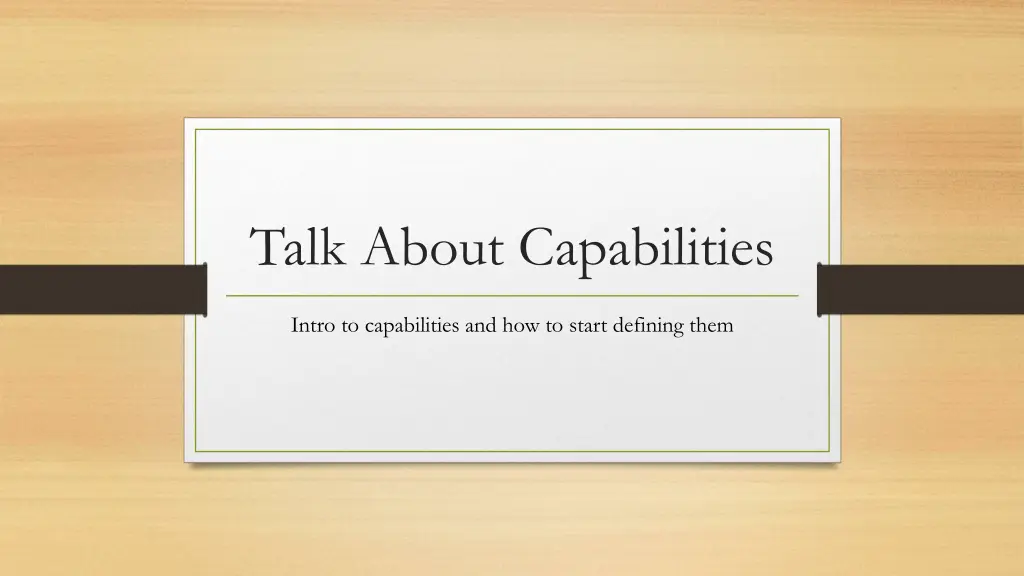
Unveiling Business Capabilities and Strategic Decision-making Essentials
Discover the significance of defining capabilities in strategic decision-making and resource allocation for enhanced business agility. Explore the essence of capabilities, strategic goals, and the levels within an organization, and learn to craft impactful business capability definitions.
Download Presentation

Please find below an Image/Link to download the presentation.
The content on the website is provided AS IS for your information and personal use only. It may not be sold, licensed, or shared on other websites without obtaining consent from the author. If you encounter any issues during the download, it is possible that the publisher has removed the file from their server.
You are allowed to download the files provided on this website for personal or commercial use, subject to the condition that they are used lawfully. All files are the property of their respective owners.
The content on the website is provided AS IS for your information and personal use only. It may not be sold, licensed, or shared on other websites without obtaining consent from the author.
E N D
Presentation Transcript
Talk About Capabilities Intro to capabilities and how to start defining them
Why Capabilities Critical for strategic decision-making Effective resource allocation Overall business agility Break down the business into its constituent capabilities, comprehensive understanding of our organization's strengths, Weaknesses areas of improvement.
What is a capability? What a business does (what it is delivering) (nouns) Ability of the organization to do something Map to strategic goals or objectives Services/software map up to capabilities May have multiple services that realize a capability Services may change with the capability generally staying the same. Fairly stable over time Can model current and future capabilities In a definition, don t include how well it needs to be done
Strategic goals and objectives Capabilities Services, processes
What it isnt Not about how or why something is done Not the processes, motivations or strategies Shouldn t reflect organizational structure People want to see themselves in any map, so this is a hard one for many people to grasp. Capabilities shouldn t overlap May exist at multiple locations in the org
Multiple Levels Levels of Capabilities Level 0 set of capabilities. 10,000 foot view of an organization. Think of this as you have 30 seconds to describe what your business does. Level 1 is a zoom in to next level of level 0 Generally, only go 5-6 levels deep but don t have to go that deep.
Business Capability Definition Template Business Capability Name Noun Ex: Recruitment Management Brief Description w/scope, purpose, and what differentiates it from other BCs Ex: The ability to solicit, quantify, and provide support for hiring new employees into the organization Description
Higher Ed Business Capability Model Educause model Don t have to start from scratch Peers starting from this model 2 Levels Descriptions are generally not there We need to localize AVT has started to think about Technology Services Capabilities
Capability Map / Model visual representation of the capabilities interdependencies within our organization how different capabilities interact and support one another to fulfill our strategic objectives. redundancies, gaps, and opportunities for optimization, enabling us to align resources more effectively and make informed decisions on resource allocation, process improvements, and technology investments.
Benefits Strategic enhances our strategic planning and execution by enabling us to identify critical capabilities that are necessary to achieve our long-term goals prioritize our investments, ensuring that resources are allocated to areas that deliver the highest value and align with our strategic priorities providing a clear view of the capabilities required to deliver products or services, we can evaluate the impact of potential changes, such as new business initiatives assess the feasibility and impact of such changes, enabling us to make well-informed decisions based on a comprehensive understanding of our organization's capabilities Operational facilitates organizational transparency and collaboration foster a shared understanding among different business units, promoting cross-functional collaboration, and breaking down silos It enables us to identify dependencies and risks, facilitating more effective communication, and enabling us to respond swiftly to changing market conditions supports our decision-making process
How to leverage Heat Mapping based on Maturity Fit to purpose Criticality Revenue Contribution or Cost Contribution Cross Mapping Where a capability exists in the org Help identify duplication and redundancy How it is used, or different levels of capability maturity Link to purpose why we have a capability Core Enabling
Sample - HR Level 1 Level 2 Level 3 Talent Hiring Searches Acquisition and Recruitment Employee Development and Training Human Resources Career Progressions Compensation and benefits management
Sample Capability to Org Mapping Organizational Units Unit A (M) Business Capability Talent Acquisition and Recruitment Employee Development and Training Compensation and Benefits Management Central HR Unit B (L) (M) (H) (L) (M) (L) Capability Maturity Heat Map
